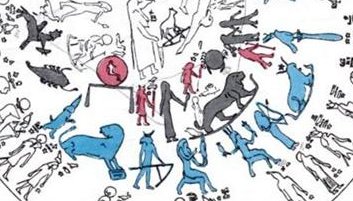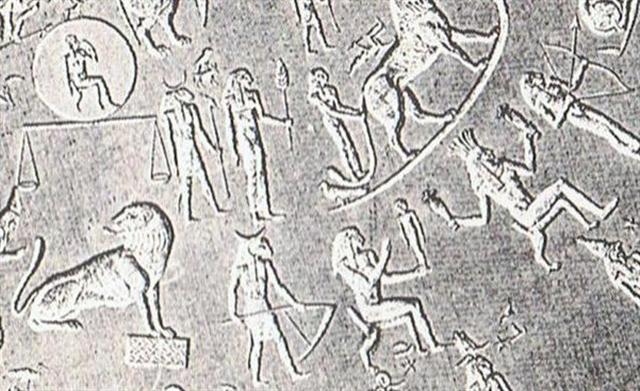7. We can look closer on the figure who evidently corresponds to Kuukuu:
I have rotated the zodiac 90° counterclockwise in order to have him at the bottom. He carries the typical farmer's tool of those times, viz. the 'digging stick' (formed like the letter A and named henen in Egypt):
To his left he has a lion looking backwards (i.e.'Kuukuu' stands at the beginning of next year). The lion has his front paws on a water basin, which we can easier perceive in this photo:
The hieroglyph for water basin (sche):
I suggest the structure of time in ancient Egypt was similar to that on Easter Island. The opening between the old land and the new land (in the sky) is located where the old land is ending (the old lion sitting down) and changing into water (the basin below his paws). A new land is later rising from the water, and the man walking forward with a digging stick, Kuukuu as I chose to call him, is proof of that. He is looking ahead while the old lion looks back on what has been. Next comes a little new Sun boy, lifted up in the left hand of the following female figure, who seems to be using the remains of the old lion as her chair, a sign of who is the father. Her forearms are drawn as a sign of opening which presumably is intended to be in contrast to the preceding henen form. From the first of the bluemarked figures (a peculiar type with what looks like a fool's hat reminding us of the Mad Hatter), we can count forward to the bird perching at the pole of summer solstice. There are 2 + 6 = 8 signs, one more than necessary for a 7-day week. On the other hand we can recognize the Old Lion (figure number 2) as Jupiter and his little Son as number 4. Thus Kuukuu (number 3) must be Saturn. Venus has not be drawn between the Jupiter and Saturn, presumably because she represents the sea (between the old and new lands). The sea cannot be drawn as a picture, the skirt of Pachamama has told us. A basin countaining water can be drawn however. |


